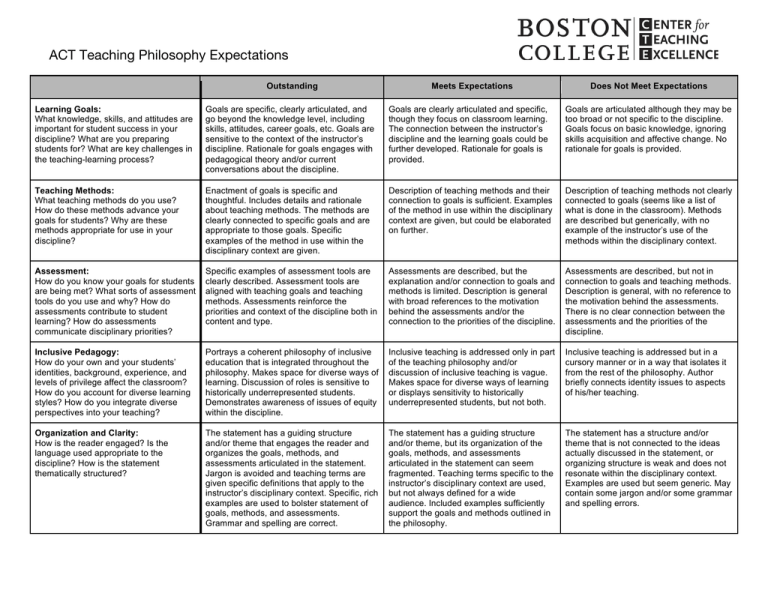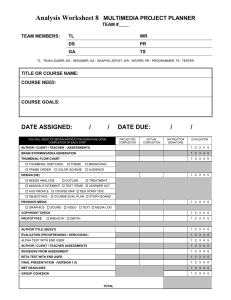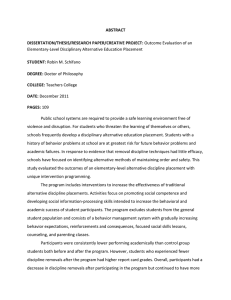ACT Teaching Philosophy Expectations
advertisement

ACT Teaching Philosophy Expectations Outstanding Meets Expectations Does Not Meet Expectations Learning Goals: What knowledge, skills, and attitudes are important for student success in your discipline? What are you preparing students for? What are key challenges in the teaching-learning process? Goals are specific, clearly articulated, and go beyond the knowledge level, including skills, attitudes, career goals, etc. Goals are sensitive to the context of the instructor’s discipline. Rationale for goals engages with pedagogical theory and/or current conversations about the discipline. Goals are clearly articulated and specific, though they focus on classroom learning. The connection between the instructor’s discipline and the learning goals could be further developed. Rationale for goals is provided. Goals are articulated although they may be too broad or not specific to the discipline. Goals focus on basic knowledge, ignoring skills acquisition and affective change. No rationale for goals is provided. Teaching Methods: What teaching methods do you use? How do these methods advance your goals for students? Why are these methods appropriate for use in your discipline? Enactment of goals is specific and thoughtful. Includes details and rationale about teaching methods. The methods are clearly connected to specific goals and are appropriate to those goals. Specific examples of the method in use within the disciplinary context are given. Description of teaching methods and their connection to goals is sufficient. Examples of the method in use within the disciplinary context are given, but could be elaborated on further. Description of teaching methods not clearly connected to goals (seems like a list of what is done in the classroom). Methods are described but generically, with no example of the instructor’s use of the methods within the disciplinary context. Assessment: How do you know your goals for students are being met? What sorts of assessment tools do you use and why? How do assessments contribute to student learning? How do assessments communicate disciplinary priorities? Specific examples of assessment tools are clearly described. Assessment tools are aligned with teaching goals and teaching methods. Assessments reinforce the priorities and context of the discipline both in content and type. Assessments are described, but the explanation and/or connection to goals and methods is limited. Description is general with broad references to the motivation behind the assessments and/or the connection to the priorities of the discipline. Assessments are described, but not in connection to goals and teaching methods. Description is general, with no reference to the motivation behind the assessments. There is no clear connection between the assessments and the priorities of the discipline. Inclusive Pedagogy: How do your own and your students’ identities, background, experience, and levels of privilege affect the classroom? How do you account for diverse learning styles? How do you integrate diverse perspectives into your teaching? Portrays a coherent philosophy of inclusive education that is integrated throughout the philosophy. Makes space for diverse ways of learning. Discussion of roles is sensitive to historically underrepresented students. Demonstrates awareness of issues of equity within the discipline. Inclusive teaching is addressed only in part of the teaching philosophy and/or discussion of inclusive teaching is vague. Makes space for diverse ways of learning or displays sensitivity to historically underrepresented students, but not both. Inclusive teaching is addressed but in a cursory manner or in a way that isolates it from the rest of the philosophy. Author briefly connects identity issues to aspects of his/her teaching. Organization and Clarity: How is the reader engaged? Is the language used appropriate to the discipline? How is the statement thematically structured? The statement has a guiding structure and/or theme that engages the reader and organizes the goals, methods, and assessments articulated in the statement. Jargon is avoided and teaching terms are given specific definitions that apply to the instructor’s disciplinary context. Specific, rich examples are used to bolster statement of goals, methods, and assessments. Grammar and spelling are correct. The statement has a guiding structure and/or theme, but its organization of the goals, methods, and assessments articulated in the statement can seem fragmented. Teaching terms specific to the instructor’s disciplinary context are used, but not always defined for a wide audience. Included examples sufficiently support the goals and methods outlined in the philosophy. The statement has a structure and/or theme that is not connected to the ideas actually discussed in the statement, or organizing structure is weak and does not resonate within the disciplinary context. Examples are used but seem generic. May contain some jargon and/or some grammar and spelling errors.





